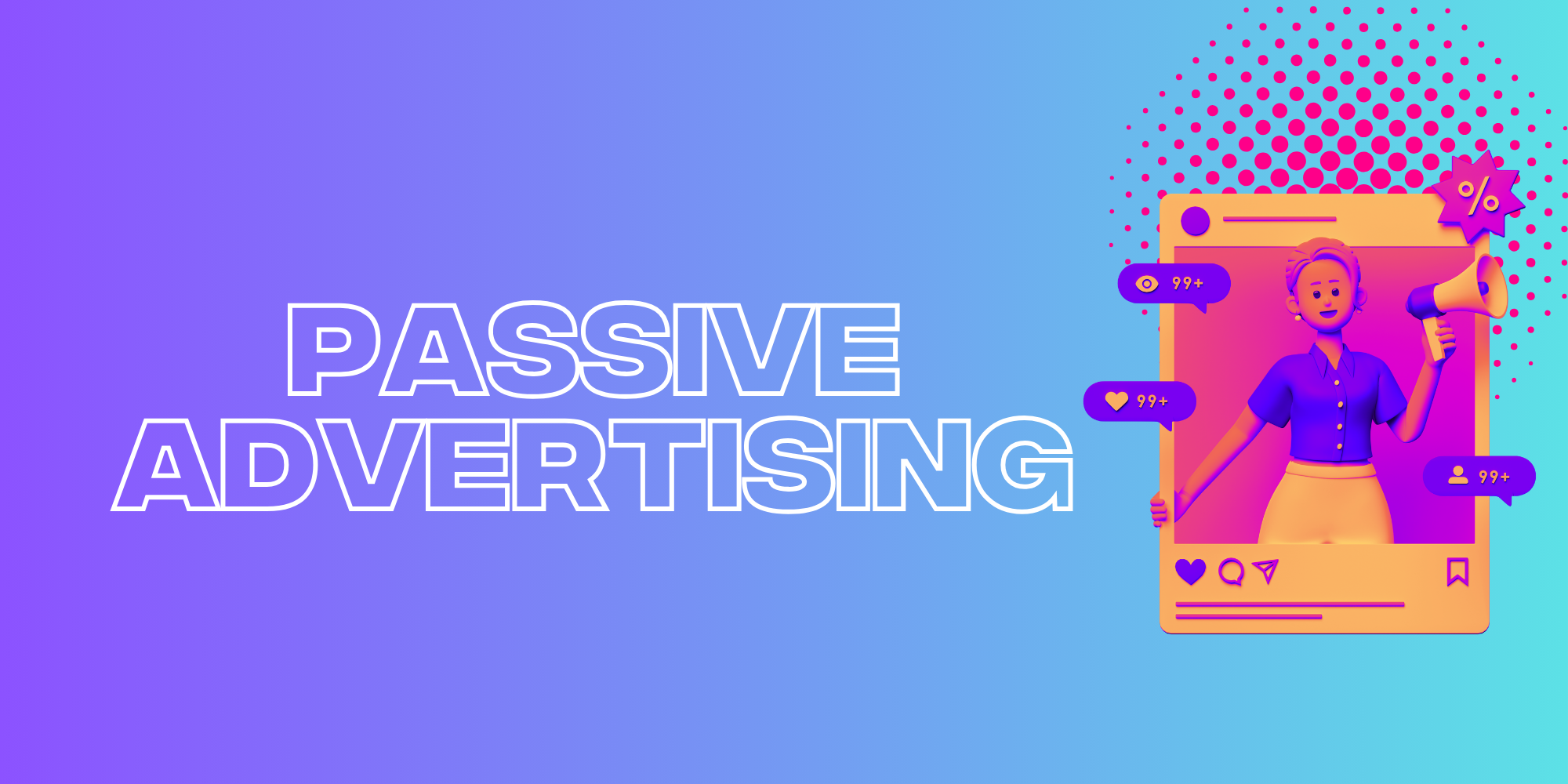Are We Starting To Move More Towards Passive Advertising?
Nov 06, 2024
Marketing News

Passive vs active advertising – what exactly IS the difference?
Passive advertising has been making the rounds on marketing social media recently, with many claiming that the age-old practice is making a comeback. Spurred by a YouTube video taht featured a subtle product placement in the background, many are seemingly convinced passive advertising is here to take over the industry.
Yet, will passive advertising ever truly reign supreme? When did it even go out of fashion in the first place?
Read on to find out more.
PASSIVE ADVERTISING VS. ACTIVE ADVERTISING
Passive and active advertising are two distinct forms of marketing, each with unique features and benefits.
Passive Advertising: Subtle and Integrated
Passive advertising is characterised by its subtle promotion of products or services.
Unlike more aggressive tactics, passive advertising aims to discreetly weave itself into the consumer’s environment without causing disruption or annoyance. This approach often utilises native advertising techniques, where ads are placed in locations where consumers are already looking, for example within website content or in the margins of a webpage.
One of the key strengths of passive advertising is its ability to appeal to consumers’ desires for organic content.
As these ads do not force their presence on the consumer, individuals have the choice to engage with the content or simply ignore it. This flexibility makes passive advertising more palatable and less intrusive; thus encouraging a more positive connection between consumer and brand. Additionally, passive advertising is often considered thoughtful and anticipatory, leading to long-lasting and sustained results.
Passive advertising often involves brands crafting an online footprint for consumers to find themselves. For example, creating a site filled with blogs answering any question a consumer may have. By leaving this information out on the internet, consumers find it when they are actively seeking the brand’s offerings; as such, they are likely to choose the brand as they are ready to engage.
Active Advertising: Bold and Immediate
Active advertising takes a more assertive approach by pushing advertisements directly into the consumer’s line of sight.
This method is typically more large-scale, aggressive, and intense, ensuring that the ads are immediately noticeable. Common examples of active advertising include pop-up ads on websites, billboards along highways, and pre-roll ads before YouTube videos. These ads are unmistakably marketing, leaving no room in the consumers’ mind for doubt on their intent.
The biggest advantage of active advertising is its ability to grab immediate attention – and lots of it.
@viralvideo.club Will they get sued for this tho? 😅 Brand is called SURREAL. #copy #copywriting #copytips #copywritingtips #marketing #marketingadvice #marketingtips #startup #startupadvice #conversionrate #landingpage #websitedesign #copywritinghacks
By placing ads in bold and prominent locations, brands are able to quickly and efficiently communicate their messages. This leads to quick consumer actions, rather than having to wait several months as in the case of passive advertising. On top of this, this kind of strategy allows brands to directly target specific demographics, thus converting viewers into customers more efficiently.
However, active advertising is not without its faults.
Active advertising has the ability to come off as too forceful or repetitive, thus alienating consumers and building a negative perception of the brand. Think of the sheer irritation of trying to watch a YouTube video but being forced to sit through a minute long ad; one doesn’t exactly leave the experience keen to find out about the brand’s offerings.

Therefore, while active advertising can be highly effective in generating quick results, it requires careful execution to avoid overwhelming or irritating the audience.
PROS AND CONS
Beyond their immediate differences, active and passive advertising differ in a myriad of smaller ways. From requiring different costs to demanding dissimilar levels of effort, each method has separate pros and cons that may make it more suitable for one brand, and the wrong choice for another.
Comparing Effort and Intent
Active and passive advertising have distinctly different levels of effort and intent.
Passive advertising can be described as the more sustainable, long term approach. This is due to the aforementioned digital footprint that this method requires; much like Hansel and Gretel, a brand must leave a tasty trail of breadcrumbs for consumers to follow, leading them to the brand’s doorstep.
This method is practical and anticipatory, aiming for continued engagement over time without the need for constant intervention. As such, passive advertising can be less effort, needing one moment in time to create the content before releasing it.
On the other hand, active advertising demands more immediate and continuous effort from businesses. Its deliberate and purposeful strategy requires constant action, skill, and persistence to yield positive results. The proactive nature of active advertising means that brands must continuously monitor and adjust their campaigns to maintain effectiveness and avoid oversaturation.

Cost Considerations
Passive advertising offers a more cost-effective option for marketers.
Passive advertising is generally a more cost-effective choice, as it often requires only a one-time investment or minimal ongoing resources. Content such as blog posts, social media posts, and website banners are common passive advertising tools that, once created, continue to generate value over time without demanding continuous attention. For example, a well-written blog post or an engaging Instagram photo can attract organic traffic indefinitely, allowing the brand to maintain visibility with minimal further input. This low-maintenance approach means smaller businesses or ones with limited marketing budgets often reach for passive advertising more.
Active advertising, however, requires more frequent updates and a larger budget.
Active campaigns must be continuously monitored, adjusted, and optimised to ensure they retain peak effectiveness. This requires a considerable commitment of both time and resources. Paid ads, for example, require regular budget allocations, and the costs can quickly add up, especially in competitive markets.
As a result, businesses engaging in active advertising often need to allocate a significant portion of their marketing budget to ensure sustained impact and visibility. This higher cost can make active advertising a less feasible option for smaller businesses, although it can deliver immediate returns for companies willing to make the investment.

Business Model and Brand Image
A brand’s business model and desired image also play important roles in determining whether to prioritise passive or active advertising.
Established businesses that already have strong brand recognition may lean toward passive advertising as a way to maintain visibility without compromising a professional, conservative image. Since passive advertising is subtle and often more aligned with organic, content-driven approaches, it allows these brands to stay relevant while respecting the consumer’s experience. This strategy may be particularly appealing to brands that want to project stability, reliability, and understated professionalism.
Conversely, active advertising is often chosen by brands that want to disrupt the market and make a bang.
Companies aiming to make a bold statement and rapidly boost sales are more likely to use active advertising, as it quickly catches consumers’ attention and boosts visibility. As such, this method is often favoured by startups and newer brands who are seeking awareness and trying to establish a foothold in a competitive landscape. This strategy allows these businesses to directly communicate with their audience, making a clear and lasting first impression.

THE BALANCING ACT
Ultimately, both passive and active advertising come with their own sets of benefits and drawbacks. When considering passive advertising effectiveness for your brand, it all boils down to your individual needs.
Passive advertising’s main advantage is its non-intrusive nature, allowing consumers to engage with ads on their own terms, which can lead to higher receptivity and a more positive brand image. However, its downside lies in the slower buildup of brand awareness and the potential for ads to be overlooked amidst abundant content.

Active advertising excels in generating immediate visibility and can drive quick conversions, making it ideal for time-sensitive campaigns or product launches. The challenge, however, is to strike the right balance between being noticeable and being intrusive. Overly aggressive ads can backfire, resulting in consumer irritation and diminished trust in the brand.
In the end, the key is striking a careful balance. A combination of both passive and active advertising allows brands to reach all audiences at all stages in their consumer journey. Whilst it is unlikely passive advertising will ever outweigh active, it is interesting to see brands adapting their passive tactics to suit more modern forms of media.
Our influencer marketing agency and social agency are located worldwide, with our agency network based in the USA, UK, UAE and China.
If you want to find industry insights, visit our influencer marketing and social media blogs.
@sociallypowerful
Social And Influencer Marketing News + Insights
Get in touch
We'll show you how to start powerful conversation, drive social engagement, build your brand, hit sales targets or meet other goals you have, wherever you are in the world.
Work with us





